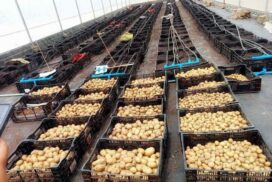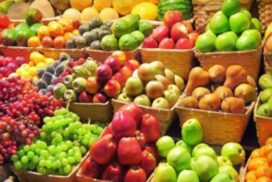It is around two decades that Chinese garlic (Kyukok) has earned a strong market share against the local garlic from Shan State.
It has been only a few years since Chinese potatoes entered the Yangon market. Yet the price is higher than local potatoes from Shan State (Aungban area). On 9 November, the supply of Chinese potatoes (54,000 visses) was seen in the Yangon markets.
The wholesale price of Chinese potatoes is K2,200-2,250 per viss. On 10 November, the prices of Shan potatoes were K1,650-1,900 per viss, while Chinese potatoes fetched K2,200-2,300 per viss.
Chinese garlic (Kyukok) started to enter Yangon markets in 2000. It has grasped a strong market share in the competitive market with Shan garlic for years. Kyukok garlic does not meet the quality of Shan garlic. But it has a strong point for its large size and it is easy to peel. It is widely used in restaurants. That way, it captured a market share.
Newly harvested garlic from Shan State usually flows into the market in the early month of the year. Meanwhile, Kyukok garlic entered the Yangon market in mid-year via the cross-border markets.
The price gap cannot be calculated. On 4 April 2022, Shan garlic was priced at K1,400-3,000 per viss depending on size, whereas the price of Kyukok garlic peaked at K5,300 per viss. When the new Kyukok garlic flooded the market on 1 June 2022, it fetched K2,700-2,800 per viss. Shan garlic was worth K1,800-3,500 per viss then. Nevertheless, Shan garlic prices moved in the range of K2,400-4,200 per viss while the Kyukok garlic price climbed up to K5,000 per viss on 1 September 2022.
On 10 November, the wholesale price of Kyukok was K3,450 per viss, while Shan garlic was valued at K3,000-4,100 per viss.
Last year, Kyukok’s price hit the maximum of 6,100 per viss on 10 December and Shan garlic price ranged from K1,500-3,000 per viss. On 11 June 2021, the prices of garlic were K1,800 for Kyukok and K1,200-1,800 for Shan garlic.
Chinese potatoes and garlic shared a market share in Yangon markets. Chinese onions usually enter Yangon markets when the prices of locally produced onions surge, making some traders raise complaints and comments (bad quality, not fit for health and easy for the curry to turn bad). Nevertheless, there is no complaint about Chinese onions at present after their onions were sold out. On 10 November, a truckload of Chinese onions entered the markets at K3,000 per viss. The size is the same as the local one. The price of Chinese onions is K1,500 lower than local ones.
The low-income family and restaurants primarily use Chinese onions. Chinese onions cannot compete against the local ones in the market when local onions are highly demanded by foreign markets. Yet it penetrated Yangon markets while the prices of local onions were exorbitantly high.
A market observer pointed out the entry of kitchen groceries (onions, garlic, potatoes) from China and captured the market share in the domestic market. — TWA/GNLM
Chinese onions, garlic, potato grasp strong market share in Yangon markets
- November 12, 2022
- 600













